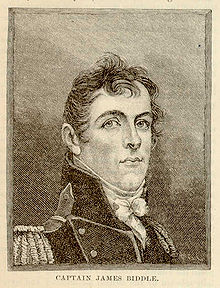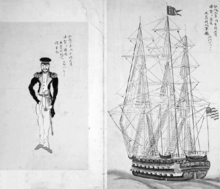James Biddle

James Biddle (February 18, 1783 – October 1, 1848), of the Biddle family, brother of financier Nicholas Biddle and nephew of Captain Nicholas Biddle, was an American commodore. His flagship was USS Columbus.
Education and early career
Biddle was born in Philadelphia, where he attended the University of Pennsylvania. After graduating, he entered service in the United States Navy as a midshipman in 1800.
Retained in the navy reduction of 1801, Biddle served in the war against the Barbary pirates. The ship he was in, USS Philadelphia, struck rocks off Tripoli, and along with his Commodore, William Bainbridge, he was kept imprisoned by the pirates for 19 months.
During the War of 1812, Biddle was first lieutenant in USS Wasp. He was in command of the sloop USS Hornet in 1815 when she defeated HMS Penguin. In 1817, he was sent to the Columbia River in the USS Ontario to formally take over the Oregon Country for the United States, which was completed in 1818.
After the war, Biddle performed various duties in the Gulf of Mexico, the South Atlantic and the Mediterranean. In 1830, Biddle and US consul David Offly negotiated and concluded a treaty with the Sublime Porte. The treaty was later used by US diplomats to claim extraterritorial privileges for US citizens in the Ottoman Empire.[1]
Expeditions to Asia



In December 1845, Biddle exchanged ratifications of the Treaty of Wanghia[2] at Poon Tong (泮塘), a village outside Guangzhou. The treaty was the first treaty between China and the United States.
On July 20, 1846, he anchored with the two warships USS Columbus and USS Vincennes in Uraga Channel at the mouth to Edo Bay in an attempt to open up Japan to trade with the United States, but was ultimately unsuccessful. Biddle delivered his request that Japan agree to a similar treaty to that which had just been negotiated with China. A few days later a Japanese junk approached Biddle's flagship and requested his presence on board their ship to receive the Tokugawa shogunate's official response. Biddle at first demurred but eventually agreed. As Biddle attempted to board the Japanese ship he misunderstood the instructions of one of the samurai guards and was physically knocked back by the guard who then drew his sword.

Biddle retreated to his flagship. The Japanese officials apologized for the mishap. Biddle eventually received the shogunate's response and was told that Japan forbade all commerce and communication with foreign nations besides that of the Dutch; also, he was informed that all foreign affairs were conducted through Nagasaki and that his ships should leave Uraga immediately.[3]
Seven years later, Commodore Matthew Perry did the task with four warships. Perry was well aware of Biddle's reception and strove to make sure that he would not be treated in the same manner.[4]
Biddle died in Philadelphia and is buried at Christ Church Burial Ground in the family plot.
See also
References
Further reading
- Long, David F. Long. (1983). Sailor-Diplomat: A Biography of Commodore James Biddle, 1783-1848 Boston: Northeastern University Press. ISBN 978-0-930350-39-0
- Sakamaki Shunzo. Japan and the United States, 1790-1853. Wilmington: Scholarly Resources, 1973.
- Sewall, John S. (1905). The Logbook of the Captain's Clerk: Adventures in the China Seas, Bangor, Maine: Chas H. Glass & Co. [reprint by Chicago: R.R. Donnelly & Sons, 1995] ISBN 0-548-20912-X
External links
![]() Media related to James Biddle at Wikimedia Commons
Media related to James Biddle at Wikimedia Commons
